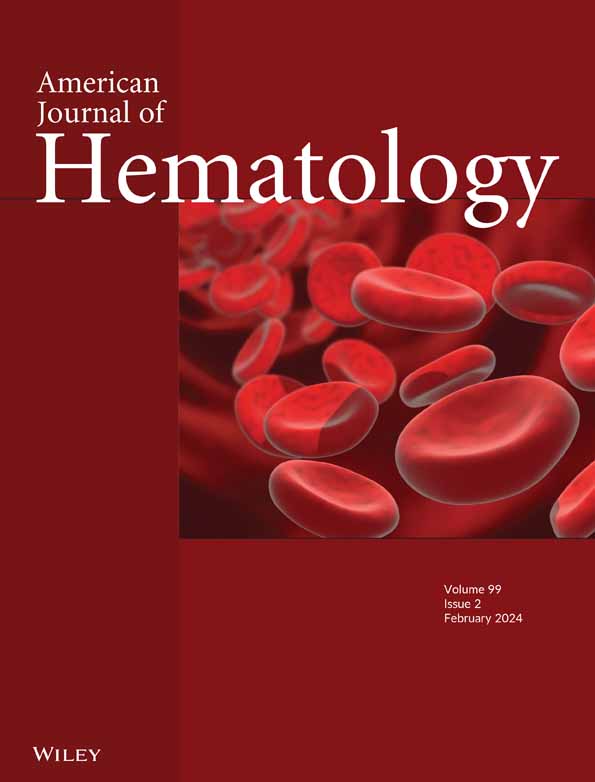International Consensus Histopathological Criteria for Subtyping Idiopathic Multicentric Castleman Disease Based on Machine Learning Analysis
IF 10.1
1区 医学
Q1 HEMATOLOGY
引用次数: 0
Abstract
Idiopathic multicentric Castleman disease (iMCD) is a rare lymphoproliferative disorder classified into three recognized clinical subtypes—idiopathic plasmacytic lymphadenopathy (IPL), TAFRO, and NOS. Although clinical criteria are available for subtyping, diagnostically challenging cases with overlapping histopathological features highlight the need for an improved classification system integrating clinical and histopathological findings. We aimed to develop an objective histopathological subtyping system for iMCD that closely correlates with the clinical subtypes. Excisional lymph node specimens from 94 Japanese iMCD patients (54 IPL, 28 TAFRO, 12 NOS) were analyzed for five key histopathological parameters: germinal center (GC) status, plasmacytosis, vascularity, hemosiderin deposition, and “whirlpool” vessel formation in GC. Using hierarchical clustering, we visualized subgroups and developed a machine learning‐based decision tree to differentiate the clinical subtypes and validated it in an external cohort of 12 patients with iMCD. Hierarchical cluster analysis separated the IPL and TAFRO cases into mutually exclusive clusters, whereas the NOS cases were interspersed between them. Decision tree modeling identified plasmacytosis, vascularity, and whirlpool vessel formation as key features distinguishing IPL from TAFRO, achieving 91% and 92% accuracy in the training and test sets, respectively. External validation correctly classified all IPL and TAFRO cases, confirming the reproducibility of the system. Our histopathological classification system closely aligns with the clinical subtypes, offering a more precise approach to iMCD subtyping. It may enhance diagnostic accuracy, guide clinical decision‐making for predicting treatment response in challenging cases, and improve patient selection for future research. Further validation of its versatility and clinical utility is required.基于机器学习分析的特发性多中心Castleman病亚型的国际共识组织病理学标准
特发性多中心性Castleman病(iMCD)是一种罕见的淋巴细胞增生性疾病,可分为三种公认的临床亚型——特发性浆细胞性淋巴结病(IPL)、TAFRO和NOS。尽管临床标准可用于分型,但具有重叠组织病理学特征的诊断挑战性病例突出了改进临床和组织病理学结果的分类系统的必要性。我们的目标是建立一个与临床亚型密切相关的iMCD客观组织病理学亚型系统。对94例日本iMCD患者(IPL 54例,TAFRO 28例,NOS 12例)的切除淋巴结标本进行了5个关键组织病理学参数的分析:生发中心(GC)状态、浆细胞增生、血管性、含铁血黄素沉积和GC“漩涡”血管形成。使用分层聚类,我们将亚组可视化,并开发了基于机器学习的决策树来区分临床亚型,并在12名iMCD患者的外部队列中进行了验证。分层聚类分析将IPL和TAFRO病例划分为相互排斥的聚类,而NOS病例则穿插在两者之间。决策树模型识别浆细胞分裂、血管性和漩涡血管形成是区分IPL和TAFRO的关键特征,在训练集和测试集分别达到91%和92%的准确率。外部验证正确分类了所有IPL和TAFRO病例,确认了系统的可重复性。我们的组织病理学分类系统与临床亚型密切相关,为iMCD亚型提供了更精确的方法。它可以提高诊断的准确性,指导临床决策,预测具有挑战性的病例的治疗反应,并为未来的研究改善患者选择。需要进一步验证其多功能性和临床实用性。
本文章由计算机程序翻译,如有差异,请以英文原文为准。
求助全文
约1分钟内获得全文
求助全文
来源期刊
CiteScore
15.70
自引率
3.90%
发文量
363
审稿时长
3-6 weeks
期刊介绍:
The American Journal of Hematology offers extensive coverage of experimental and clinical aspects of blood diseases in humans and animal models. The journal publishes original contributions in both non-malignant and malignant hematological diseases, encompassing clinical and basic studies in areas such as hemostasis, thrombosis, immunology, blood banking, and stem cell biology. Clinical translational reports highlighting innovative therapeutic approaches for the diagnosis and treatment of hematological diseases are actively encouraged.The American Journal of Hematology features regular original laboratory and clinical research articles, brief research reports, critical reviews, images in hematology, as well as letters and correspondence.

 求助内容:
求助内容: 应助结果提醒方式:
应助结果提醒方式:


